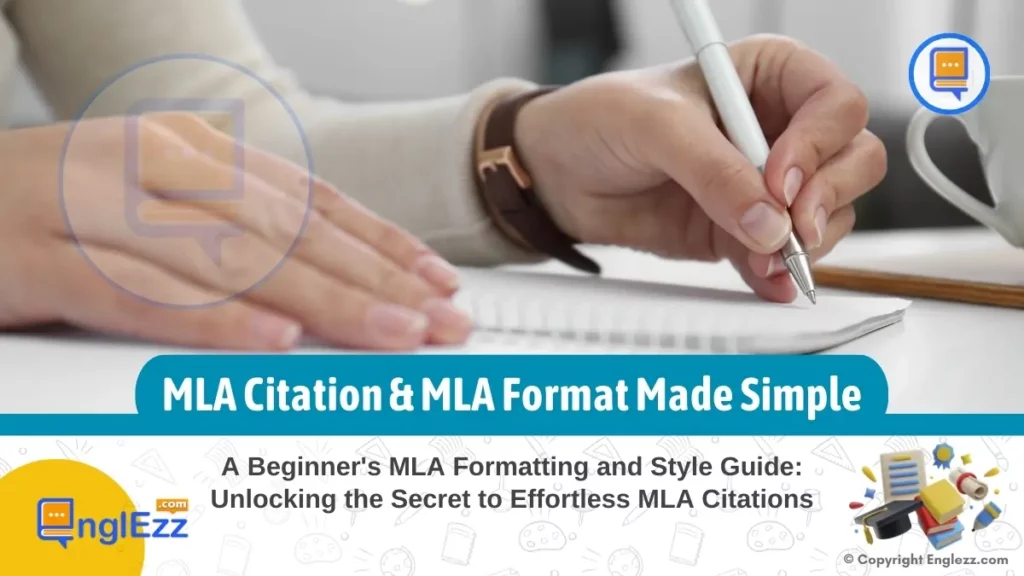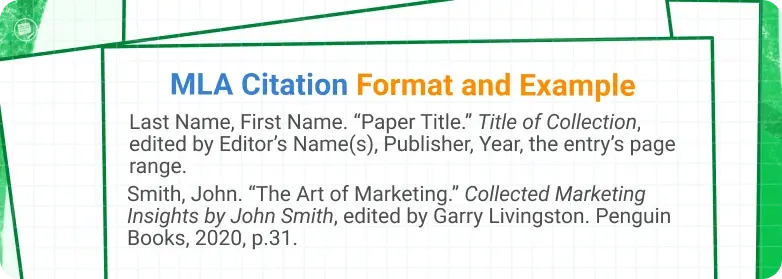In the scholarly realm where knowledge reigns supreme, citations stand as the guardians of academic integrity, guiding readers to the wellspring of wisdom that shapes our understanding of the world. However, for many newcomers embarking on their educational journey, navigating the maze of MLA guidelines can seem akin to deciphering ancient hieroglyphics. Fear not, for within this digital oasis lies a beacon of enlightenment: “MLA Made Simple: A Beginner’s Guide to Proper Citations” – a treasure trove waiting to unlock the secrets to effortless MLA citations.
Table of Contents
- MLA Citation Made Simple: A Beginner’s MLA Formatting and Style Guide
- Unlocking the Basics of MLA Citations
- Formatting In-text Citations Like a Pro
- Mastering Works Cited Pages with Ease
- Examples of MLA format and MLA citations
- The Importance of Ethical Citation Practices
- Navigating Parenthetical Citations: A Comprehensive Guide
- Incorporating Quotes Effectively in MLA Papers
- MLA Format & MLA Citation Generator
- Unlocking Effortless Mastery of MLA Citations
- Resources for Ongoing Learning
- FAQs:
MLA Citation Made Simple: A Beginner’s MLA Formatting and Style Guide
Imagine a world where citing sources becomes not a dreaded chore but a skill that elevates your academic prowess. As we embark on this illuminating quest together, we shall unravel the intricate tapestry of MLA citations with finesse and clarity. By simplifying the complexities that often bewilder beginners, we aim not just to educate but to empower – equipping students, educators, researchers, and academic writers with the tools they need to soar in their scholarly pursuits.

Let us embark on this transformative journey hand in hand, as we demystify the labyrinthine paths of proper citation practices while fostering a renewed appreciation for the art of attributing knowledge responsibly.
Unlocking the Basics of MLA Citations
In the labyrinth of academic writing, proper citation serves as a guiding light, illuminating the scholarly pathway. Understanding the fundamental components of an MLA citation is akin to deciphering a code; each piece contributes to the puzzle of acknowledging sources effectively. The author’s name, title of the work, publication date, and other crucial elements play a symphonic role in composing a harmonious citation that sings praises to the original creators. For instance, when citing a book in MLA style, remember to include not just the author’s name and title but also specific publication details like the publisher and year of publication. These nuances add depth and richness to your citations, reflecting meticulous attention to detail.
Navigating through various source types can resemble traversing different terrains in academia – from digital landscapes like websites and online articles to traditional realms such as printed books and scholarly journals. Here, step-by-step instructions become your trusty map, guiding you through formatting each source type in MLA style with precision. For example, when citing an online article, ensure including the URL or DOI along with traditional citation details. Mastering these basics isn’t just about compliance; it’s about respect for intellectual discourse and contributing meaningfully to academic conversations.
The essence of mastering these foundational aspects lies in elevating your writing from mere regurgitation of information to a thoughtful engagement with existing scholarship. Without proper citations, your work risks being adrift without anchor or context – lost in a sea of unattributed ideas. Precise citations not only enhance credibility but also showcase your commitment to upholding academic integrity at its core.
In essence, by mastering these basics early on in your academic journey, you lay a solid foundation for building knowledge ethically while respecting others’ intellectual endeavors – a cornerstone of quality academic writing that resonates across disciplines and generations alike.
Formatting In-text Citations Like a Pro
When it comes to academic writing, mastering the art of in-text citations is crucial for maintaining credibility and integrity within your work. Understanding the rules and nuances of inserting in-text citations according to MLA standards can seem daunting at first, but with the right guidance, you’ll be able to navigate this aspect of citation with confidence. In MLA style, in-text citations typically include the author’s last name and the page number where the information was found.
One crucial tip to remember when dealing with MLA citations is to maintain consistency throughout your document. Ensure that your formatting, citation style, and reference list follow the same conventions to avoid confusion for both yourself and readers. Consistent citation practices not only enhance the readability of your work but also demonstrate attention to detail and professionalism in your academic writing. For example, if you italicize the titles of books in your citations, make sure you do so consistently for all sources cited.
For example, (Smith 26). However, if you mention the author’s name in your sentence, you only need to include the page number in parentheses: “According to Smith (26)…
To seamlessly integrate in-text citations into your academic papers, remember that they should directly support your arguments or ideas by providing evidence from credible sources. Avoid overusing direct quotations and strive to paraphrase information whenever possible while still acknowledging the original source. A best practice is to strategically place your in-text citation after any direct quotes or paraphrased material to indicate where your information originated. By doing so, you create a strong foundation for your own arguments while honoring the intellectual contributions of others.
Common pitfalls when incorporating in-text citations include forgetting to add them altogether, incorrectly formatting them according to MLA guidelines, or failing to match them with their corresponding works cited entries. To avoid these errors, double-check every citation for accuracy and consistency throughout your paper. Remember that each in-text citation should correspond with a full reference on your works cited page. By staying vigilant and following MLA standards closely, you can elevate the quality of your academic writing and ensure that your research is properly attributed.
Mastering Works Cited Pages with Ease
In the realm of academic writing, a well-crafted works cited page holds immense importance as it not only showcases your research efforts but also upholds the integrity of your work. Organizing sources in an MLA works cited page involves meticulous attention to detail. One key aspect is arranging sources alphabetically by the author’s last name or by the title if no author is provided, followed by other publication details. However, for sources like websites and online articles with no page numbers, citing can be a bit tricky. In such cases, consider using alternative markers like paragraph numbers or section headings for clarity.
Implementing hanging indents, where the first line of each citation starts at the left margin while subsequent lines are indented, provides a polished look to your works cited page. This formatting style enhances readability and distinguishes each entry clearly. Including all necessary details such as authors’ names, titles of sources, publication dates, and relevant page numbers ensures that readers can easily locate and verify your cited references. Remember that consistency in formatting is key to presenting a professional-looking works cited page that adheres to MLA guidelines.

To streamline the creation of your works cited pages, leverage digital tools and templates designed specifically for MLA citations. Citation management software like Zotero or online citation generators can significantly reduce the manual effort required for formatting individual entries correctly. These tools not only save time but also offer error-checking features to ensure accuracy in citing various source types. By incorporating these technological aids into your workflow, you can focus more on crafting quality content while ensuring that your works cited pages meet rigorous academic standards effortlessly.
Examples of MLA format and MLA citations
Here are three examples of MLA format and MLA citations:
Book Citation:
Smith, John. The Great American Novel. Penguin Books, 1987.
Explanation:
- Author’s last name, first name
- Book title in italics
- Publisher
- Publication date
Journal Article Citation:
Jones, Mary. “The Impact of Social Media on Communication.” Journal of Communication Studies, vol. 12, no. 3, 2018, pp. 45-60.
Explanation:
- Author’s last name, first name
- Article title in quotation marks
- Journal title in italics
- Volume number, issue number (if applicable)
- Page range
Website MLA Citation:
National Aeronautics and Space Administration. “Mars Exploration Program.” NASA, 2021, www.nasa.gov/mission_pages/mars/index.html.
Explanation:
- Website name or organization
- Specific webpage title in quotation marks
- Website publisher (if different from website name)
- Publication date (if available)
- URL
These examples demonstrate the basic format for citing books, journal articles, and websites in MLA style. The key is to provide enough information to allow someone to locate and access the original source.
The Importance of Ethical Citation Practices
In the academic realm, citing sources ethically isn’t just about following rules—it’s a fundamental aspect of integrity and respect for the intellectual community. Proper citation practices are like signposts in a scholarly landscape, guiding readers to the origins of ideas and giving credit where it is due. By acknowledging the works that have influenced our own research, we not only demonstrate academic honesty but also support the collaborative nature of knowledge-building. Just as we appreciate others citing our work, we should reciprocate by attributing their contributions in our own writing.
Before submitting any academic paper or research project, take the time to proofread your citations meticulously. Check for accuracy in author names, publication dates, page numbers, and other essential details within your citations. A small error in a citation can have a significant impact on the credibility of your work, so double-checking each reference ensures that your sources are correctly attributed and formatted according to MLA guidelines. For instance, when citing multiple works by the same author in your text, ensure each entry is unique and accurately reflects the source.
Accurate citations serve as pillars of credibility in academic writing. They provide readers with a roadmap to trace back the information presented to its primary sources, fostering transparency and trust. When we meticulously cite our sources, we show reverence for intellectual property rights and uphold ethical standards within scholarly discourse. By recognizing the efforts of those who have paved the way for our research endeavors, we contribute to a culture of mutual respect and recognition among academics.
As aspiring researchers or seasoned academics, it’s paramount that we heed the call to maintain ethical citation practices in all our written works. Whether crafting a thesis or composing an article for publication, citing sources accurately not only safeguards against accusations of plagiarism but also enriches our narratives by embedding them within broader scholarly conversations. By embracing ethical citation norms, we amplify the voices of past scholars and contemporaries alike, honoring their intellectual legacies while forging new paths in academia through responsible information dissemination.
In the realm of academic writing, mastering parenthetical citations is akin to wielding a precision instrument in crafting a well-researched paper. These concise in-text citations serve as signposts guiding readers to the corresponding entries on the works cited page while bolstering your arguments with scholarly evidence. Understanding when and how to incorporate these parenthetical citations seamlessly within your prose is essential for upholding the standards of MLA guidelines.
Imagine you’re composing an analysis of Shakespeare’s “Romeo and Juliet,” and you wish to reference Act 3, Scene 5. To properly incorporate a quote such as Juliet’s famous line, “What’s in a name? That which we call a rose by any other name would smell as sweet,” you would include a parenthetical citation after the quote (Shakespeare 3.5.43-44). This not only acknowledges the source material but also provides precise information for readers to locate the original text in your works cited list.
To further clarify this intricate process, let’s consider a scenario where you are integrating sources from multiple authors in one paragraph. In such cases, each parenthetical citation must clearly indicate which source it corresponds to without causing confusion for readers. By following these nuanced guidelines and offering clear examples tailored to different citation situations, our comprehensive guide aims to demystify the art of using parenthetical citations effectively within written content while adhering to MLA standards.
Incorporating Quotes Effectively in MLA Papers
Integrating quotes from external sources in academic papers under the MLA citation style can elevate the quality of your writing by adding credibility and depth to your arguments. When incorporating quotes, it is crucial to ensure that they are seamlessly woven into your own narrative while following the guidelines set forth by MLA. Addressing common challenges such as fragmentary quotes or mismatched attributions is key to maintaining the integrity of your work. For instance, when using a quote that doesn’t fit organically within your sentence structure, consider paraphrasing it instead to align better with the flow of your paper.
While mastering MLA citations may seem daunting at first, leveraging digital tools designed for citation management can simplify the process and increase efficiency. Explore citation generators like Zotero or EasyBib that automatically format references according to MLA standards based on information you input about a source. These tools not only save time but also reduce the chances of errors creeping into your bibliographies or works cited pages. Remember, while digital aids are helpful shortcuts, it’s still crucial to understand the underlying principles of MLA formatting for academic success.
One way to enhance the effectiveness of quotes in your writing is to critically engage with the material you’re quoting. Whether you agree or disagree with a particular point, providing thoughtful analysis alongside quoted material showcases a higher level of academic rigor. Emphasizing accuracy and relevance in quoting practices ensures that each quote serves a specific purpose in supporting or challenging your thesis. By critically evaluating the significance of each quote within the context of your argument, you demonstrate a thorough understanding of both the source material and its implications for your research.
Consistency in formatting according to MLA requirements is essential when incorporating quotes into your paper. This consistency not only ensures adherence to academic standards but also aids readers in identifying and verifying the quoted sources easily. Paying attention to details such as punctuation, attribution, and citation placement helps maintain a polished and professional appearance for your work. Remember, by embedding quotes effectively within your writing while upholding MLA guidelines, you not only enrich your content but also demonstrate respect for the original authors’ contributions.
MLA Format & MLA Citation Generator
Scribbr MLA Citation Generator
Unlocking Effortless Mastery of MLA Citations
As we come to the end of our journey through the intricate realm of MLA citations, remember that mastering the art of proper citation not only showcases your academic integrity but also honors the intellectual contributions that have shaped your work. By simplifying the complexities of MLA guidelines and breaking down each component into manageable steps, we’ve empowered you to navigate the world of citations with confidence and ease.
We hope this beginner’s guide has demystified the process of creating impeccable MLA citations for you. Whether you’re a student striving for excellence in research papers, an educator guiding new learners through scholarly writing, or a researcher uncovering groundbreaking discoveries, remember that accurate and ethical citation practices are foundational to advancing knowledge and fostering credibility in academia.
As you embark on your continued learning journey, exploring additional resources such as citation generators, style guides, and interactive tutorials will further enhance your skills in crafting flawless MLA citations. Remember, every properly cited source is not just a nod to academic conventions but a testament to your respect for intellectual honesty and dedication to producing high-quality work. So here’s to effortless mastery of MLA citations—may your future academic endeavors be enriched by the power of proper attribution.
Resources for Ongoing Learning
As you embark on your journey to master the art of MLA citations, remember that simplicity is key. By grasping the foundational aspects of formatting works cited pages and integrating in-text citations effectively, you are already well on your way to becoming a citation connoisseur. The secret lies in understanding the rules and applying them consistently throughout your academic endeavors.
To support your ongoing learning and ensure effortless citation practices, various resources are at your disposal. Citation generators like EasyBib or BibMe can streamline the process of creating accurate citations across different source types. Style guides such as Purdue Owl’s MLA Formatting and Style Guide offer detailed explanations and examples for proper MLA formatting. Interactive tutorials from universities or online platforms can also provide engaging opportunities to practice citation skills in a structured environment.
Just like mastering any skill, practice makes perfect when it comes to MLA citations. Keep honing your knowledge by referencing these resources, seeking guidance from educators or librarians, and incorporating feedback into your writing process. Remember, with every correctly formatted citation, you are not only upholding academic integrity but also enriching your own work through the acknowledgment of others’ contributions. Here’s to unlocking the secret to effortless MLA citations!
FAQs:
Q: Why is citing sources important?
A: Citing sources is crucial as it gives credit to original authors, avoids plagiarism accusations, and allows readers to verify your claims.
Q: What if I can’t find all the information needed for an MLA citation?
A: If certain details are missing, prioritize including what you have (like author name or title) and follow MLA guidelines for incomplete citations.
Q: Can I use citation management tools for creating MLA citations?
A: Yes! Tools like Zotero or EndNote can streamline the process by organizing your sources and formatting them according to MLA style.
Q: Is there a difference between APA and MLA citations?
A: Yes, they have distinct formatting rules. APA often uses dates while MLA focuses on authors’ names – consult specific style guides for accuracy.
Q: What should I do if I quote someone else’s work verbatim in my paper?
A: When directly quoting text word for word, ensure it is enclosed in quotation marks with an accompanying in-text citation following proper MLA guidelines.









Master MLA Citation effortlessly with this beginner’s guide to MLA Formatting and Style. Simplify your citations now!